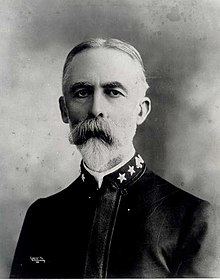William Thomas Sampson
William Thomas Sampson (born February 9, 1840 in Palmyra , New York , † May 6, 1902 in Washington, DC ) was an American Rear Admiral in the United States Navy . He became famous for his victory in the naval battle of Santiago de Cuba during the Spanish-American War .
Sampson began his training at the United States Naval Academy on September 24, 1857 . After graduating from the top of his class four years later, he worked at the Academy as a trainer. In 1864 he became First Officer of the Patapsco Monitor , which was part of the South Atlantic Blockading Squadron, and was used to clear sea mines off Charleston , South Carolina . He survived the loss of the armored ship on January 16, 1865 when it hit a sea mine, exploded, killing 75 people when it sank.
He then served on the steam frigate USS Colorado in the European squadron , again as an academy instructor, in the navigation office of the United States Department of the Navy and on the sloop USS Congress . He then commanded the USS Alert , the training ship USS Mayflower and the USS Swatara . For the next few years he was assistant to the superintendent of the United States Naval Observatory and operations manager of the Naval Torpedo Station in Newport, Rhode Island . On September 9, 1886, he became superintendent of the Naval Academy. On April 9, 1889, he was appointed captain , assigned to the Mare Island Navy Yard to set up the USS San Francisco , and took command when this protected cruiser entered service on November 15, 1889. In June 1892 he was posted to serve as Inspector of Ordnance in the Washington Navy Yard , and on January 28, 1893, appointed Chief of the Bureau of Ordnance . On June 15, 1897, he took command of the battleship USS Iowa and on February 17, 1898, he was appointed President of the Board of Inquiry to investigate the destruction of the USS Maine . On March 26, 1898, he took over command of the North Atlantic Squadron with the provisional rank of Rear Admiral .
On April 21, 1898, the USA declared war on Spain and eight days later Admiral Cervera's fleet set sail from Cape Verde with an uncertain destination. Admiral Sampson set sail from Key West in the flagship USS New York to search for the Spanish fleet, and on June 1, 1898, established a tight and efficient blockade in the port of Santiago de Cuba . On the morning of July 3, Cervera's fleet came out of port and was completely destroyed in a naval battle within five hours. The next day, Sampson sent his famous message: "The fleet under my command offers the nation as a Fourth of July present the whole of Cervera as a gift to the nation." ("The Fleet under my command offers the nation as a Fourth of July present, the whole of." Cervera's Fleet. ")
On August 20, 1898, he was appointed Commissioner for Cuba , but in December he returned to command of the North Atlantic Fleet. In October 1899 he became the commandant of the Boston Navy Yard and on February 9, 1902, he was added to the list of retirees. A few months later he died in Washington and was buried in Arlington National Cemetery .
Four destroyers are named USS Sampson in his honor . The United States Naval Academy named Sampson Hall after him and awarded the Sampson Medal to those who served under his command in the Spanish-American War.
| personal data | |
|---|---|
| SURNAME | Sampson, William Thomas |
| BRIEF DESCRIPTION | United States Navy Rear Admiral |
| DATE OF BIRTH | February 9, 1840 |
| PLACE OF BIRTH | Palmyra , New York |
| DATE OF DEATH | May 6, 1902 |
| Place of death | Washington, DC |
